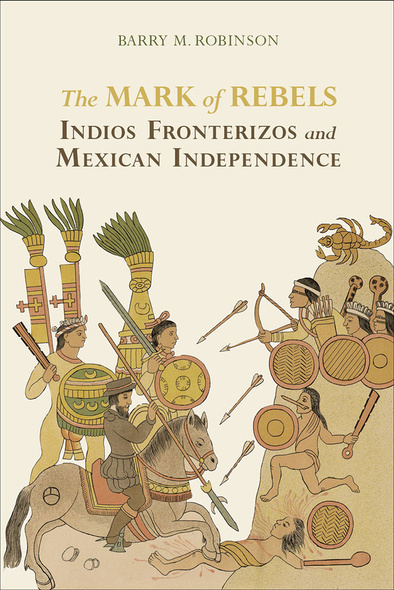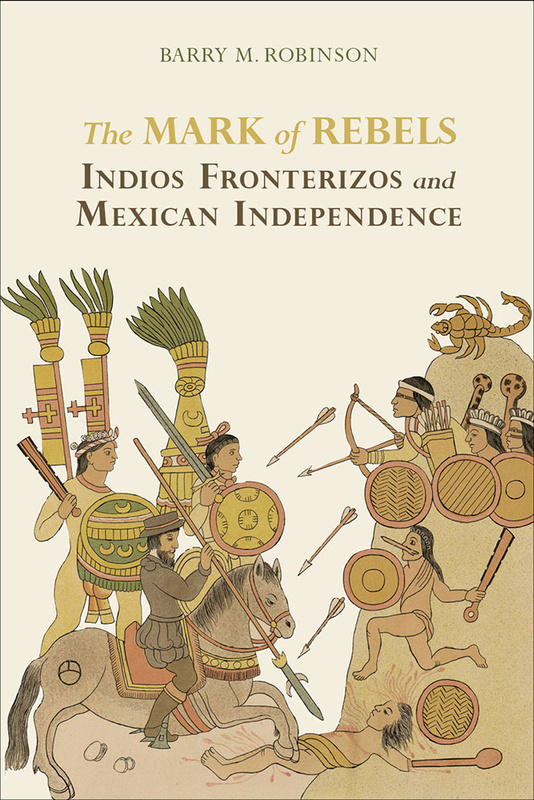
208 pages, 6 x 9
3 B&W figures - 2 maps - 2 tables
Paperback
Release Date:09 Nov 2021
ISBN:9780817360467
The Mark of Rebels
Indios Fronterizos and Mexican Independence
SERIES:
Atlantic Crossings
University of Alabama Press
Explores social and cultural transformations among the indigenous communities of western Mexico, especially the indios fronterizos (Frontier Indians), preceding and during the struggle for independence
In The Mark of Rebels Barry Robinson offers a new look at Mexican Independence from the perspective of an indigenous population caught in the heart of the struggle. During the conquest and settlement of Mexico’s Western Sierra Madre, Spain’s indigenous allies constructed an indio fronterizo identity for their ethnically diverse descendants. These communities used their special status to maintain a measure of autonomy during the colonial era, but the cultural shifts of the late colonial period radically transformed the relationship between these indios fronterizos and their neighbors.
Marshalling an extensive array of archival material from Mexico, the United States, and Spain, Robinson shows that indio fronterizo participation in the Mexican wars of independence grafted into the larger Hidalgo Revolt through alignment with creole commanders. Still, a considerable gulf existed between the aims of indigenous rebels and the creole leadership. Consequently, the privileges that the indios fronterizos sought to preserve continued to diminish, unable to survive either the late colonial reforms of the Spanish regime or creole conceptions of race and property in the formation of the new nation-state.
This story suggests that Mexico’s transition from colony to nation can only be understood by revisiting the origins of the colonial system and by recognizing the role of Spain’s indigenous allies in both its construction and demolition. The study relates events in the region to broader patterns of identity, loyalty, and subversion throughout the Americas, providing insight into the process of mestizaje that is commonly understood to have shaped Latin America. It also foreshadows the popular conservatism of the nineteenth century and identifies the roots of post-colonial social unrest.
This book provides new context for scholars, historians, ethnographers, anthropologists, and anyone interested in the history of Mexico, colonization, Native Americans, and the Age of Revolutions.
In The Mark of Rebels Barry Robinson offers a new look at Mexican Independence from the perspective of an indigenous population caught in the heart of the struggle. During the conquest and settlement of Mexico’s Western Sierra Madre, Spain’s indigenous allies constructed an indio fronterizo identity for their ethnically diverse descendants. These communities used their special status to maintain a measure of autonomy during the colonial era, but the cultural shifts of the late colonial period radically transformed the relationship between these indios fronterizos and their neighbors.
Marshalling an extensive array of archival material from Mexico, the United States, and Spain, Robinson shows that indio fronterizo participation in the Mexican wars of independence grafted into the larger Hidalgo Revolt through alignment with creole commanders. Still, a considerable gulf existed between the aims of indigenous rebels and the creole leadership. Consequently, the privileges that the indios fronterizos sought to preserve continued to diminish, unable to survive either the late colonial reforms of the Spanish regime or creole conceptions of race and property in the formation of the new nation-state.
This story suggests that Mexico’s transition from colony to nation can only be understood by revisiting the origins of the colonial system and by recognizing the role of Spain’s indigenous allies in both its construction and demolition. The study relates events in the region to broader patterns of identity, loyalty, and subversion throughout the Americas, providing insight into the process of mestizaje that is commonly understood to have shaped Latin America. It also foreshadows the popular conservatism of the nineteenth century and identifies the roots of post-colonial social unrest.
This book provides new context for scholars, historians, ethnographers, anthropologists, and anyone interested in the history of Mexico, colonization, Native Americans, and the Age of Revolutions.
In The Mark of Rebels, Barry Robinson offers a valuable new perspective on the role of indigenous communities in late colonial politics, the independence struggle itself, and the resolution processes that undergirded postwar Mexico. . . . His book will enlighten scholars, students, and interested lay readers concerned with indigenous politics, militia service, and the comparison of revolutions.'
—Michigan War Studies Review
‘The Mark of Rebels is a well-written, intensively researched account that presents a theoretically important view of local variation in the conflicts of late colonial New Spain and the origins of independent Mexico. It belongs on the must-read shelf of anyone interested in those topics or in the historical development of race/class relations in Mexico generally.’
—Journal of Latin American and Caribbean Anthropology
Robinson's research is prodigious and original. He culls fascinating source material from widely scattered archives and produces quantitative data about ethnic identity and allegiances during the independence movement. Furthermore, he does so for a region that we know little about.'
—Yanna Yannakakis, author of The Art of Being In-between: Native Intermediaries, Indian Identity, and Local Rule in Colonial Oaxaca
'This is a nuanced study that shows a distinct region in a time of flux and centers on the role of the indigenous and ethnic identities in late colonial New Spain.'
—Scott Eastman, coeditor of The Rise of Constitutional Government in the Iberian Atlantic World: The Impact of the Cádiz Constitution of 1812
Barry Robinson is an associate professor of history at Queens University of Charlotte and the coeditor of Slaves, Subjects, and Subversives: Blacks in Colonial Latin America.









